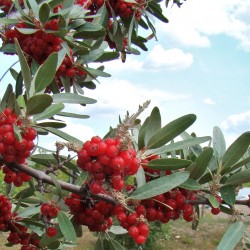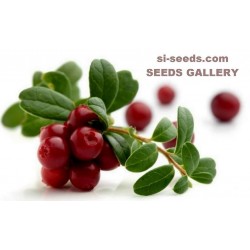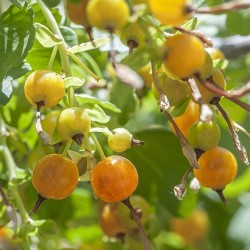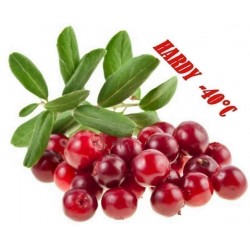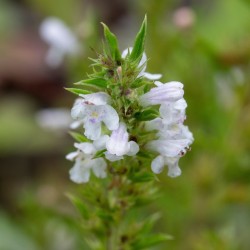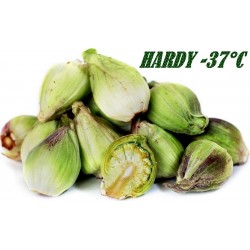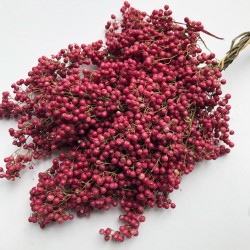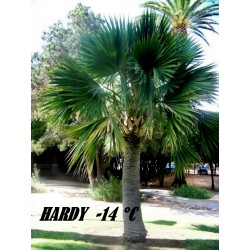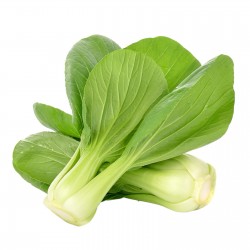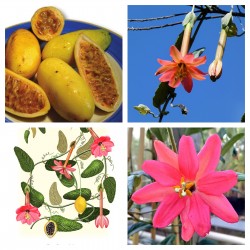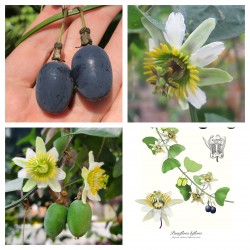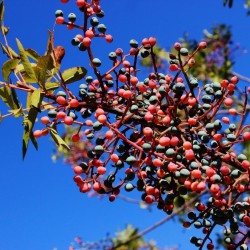
Семена Терпенти́нное...
Цена
2,05 €
SKU: T 95
Seeds Gallery Com,
5/
5
<meta http-equiv="Content-Type" content="text/html; charset=UTF-8" />
<h2>Семена Терпенти́нное де́рево (Pistácia terebínthus)</h2>
<h2><span style="color: #ff0000;">Цена за пакет из 10 семян.</span></h2>
<p><b>Терпенти́нное де́рево</b><span> </span>(лат. <span lang="la" xml:lang="la">Pistácia terebínthus</span>) —<span> </span>вид<span> </span>небольших<span> </span>листопадных<span> </span>деревьев<span> </span>и<span> </span>кустарников<span> </span>рода<span> </span>Фисташка<span> </span>семейства<span> </span>Сумаховые<span> </span>(<i><span lang="la" xml:lang="la">Anacardiaceae</span></i>).</p>
<p>Естественная область распространения находится в<span> </span>Средиземноморье<span> </span>от<span> </span>Марокко<span> </span>и<span> </span>Португалии, включая<span> </span>Канарские острова, до<span> </span>Греции, западной<span> </span>Турции<span> </span>и восточного побережья<span> </span>Средиземного моря —<span> </span>Сирии,<span> </span>Ливана<span> </span>и<span> </span>Израиля. Встречается на сухих склонах гор, в светлых лесах.</p>
<div class="toctitle" lang="ru" dir="ltr" xml:lang="ru"></div>
<h2 id="toc" class="toc"><span></span><span class="mw-headline">Описание</span></h2>
<p>Крупный кустарник или небольшое дерево высотой около 5 метров, иногда до 10.</p>
<p>Листья<span> </span>длиной 10—20 см сложные, непарноперистые, содержат от 3 до 9 листочков.</p>
<p>Цветки, однополые красновато-фиолетового цвета, мелкие, собраны в крупную метёлку. Появляются ранней весной вместе с новыми листьями.<span> </span>Околоцветникпростой, состоит из 2—6 листочков.</p>
<p>Плоды — мелкие шаровидные<span> </span>костянки<span> </span>длиной 5—7 мм, красного цвета, чернеют при созревании.</p>
<p>Все части растения имеют сильный смолистый запах.</p>
<h2><span></span><span class="mw-headline">Применение</span></h2>
<p>Растение отличается высоким содержанием<span> </span>танина<span> </span>и смолистых веществ, и известно ещё с древности. Его ароматические и лечебные свойства использовались в медицине классической Греции. На<span> </span>Кипре<span> </span>плоды использовали при выпечке хлеба.</p>
<p>Дерево служит источником<span> </span>терпентина, который добывают<span> </span>подсочкой. Получаемая смолка содержит<span> </span>эфирное масло, сходное со<span> </span>скипидаром.<span> </span>Терпентинное масло<span> </span>получают из семян. Предположительно, это растение служило самым ранним источником скипидара, известным человечеству. Скипидар из фисташек ещё называют кипрский, или хиосский скипидар.</p>
<p>При дублении кож используют<span> </span>дубильные вещества, которые содержатся в<span> </span>галлах, вызываемых<span> </span>тлями.</p>
<h2><span></span><span class="mw-headline">Таксономия</span></h2>
<ul>
<li><span><b>Pistacia terebinthus</b></span> <span>L.</span><span> </span>Species Plantarum<span> </span>2:1025. 1753.</li>
</ul>
<h3><span></span><span class="mw-headline">Разновидности</span></h3>
<ul>
<li><span>Pistacia terebinthus</span><span> subsp. </span><span>terebinthus</span></li>
<li><span>Pistacia terebinthus</span><span> subsp. </span><span>palaestina</span> <span>(Boiss.) Engl.</span><span> </span>[syn.<span> </span><span lang="la" xml:lang="la">Pistacia palaestina</span><span> </span><span>Boiss.</span>]</li>
</ul>
<div class="thumb tleft">
<div class="thumbinner"><img alt="" src="https://upload.wikimedia.org/wikipedia/commons/thumb/3/3c/Pistacia_terebinthus_MHNT.BOT.2009.13.55.jpg/220px-Pistacia_terebinthus_MHNT.BOT.2009.13.55.jpg" width="220" height="160" class="thumbimage" />
<div class="thumbcaption">
<div class="magnify"></div>
Плоды</div>
</div>
</div>
<div class="thumb tright">
<div class="thumbinner"><img alt="" src="https://upload.wikimedia.org/wikipedia/commons/thumb/4/4c/Pistachier2.JPG/220px-Pistachier2.JPG" width="220" height="166" class="thumbimage" />
<div class="thumbcaption">
<div class="magnify"></div>
Соцветие</div>
</div>
</div>
<h2><span></span><span class="mw-headline">Терпентинное дерево в Библии</span></h2>
<p><b>Тереви́нф</b><span> </span>(др.-греч.<span> </span><span lang="grc" xml:lang="grc"><span>τερέβινθος, τερέμινθος</span></span>,<span> </span>лат. <span lang="la" xml:lang="la">terebinthus, terebinthum</span>):<span> </span>Быт. 14:6,<span> </span>Быт. 35:4,<span> </span>Быт. 43:11<span> </span>— фисташки<sup id="cite_ref-2" class="reference">[2]</sup>,<span> </span>Ос. 4:13,<span> </span>Ис. 1:30,<span> </span>Ис. 6:13,<span> </span>Сир. 24:19.</p>
<p>Означенное дерево иногда смешивают с<span> </span>дубом, но это неправильно. Теревинф есть особенное дерево из семейства фисташковых, растет в южной Европе, как небольшое кустарное дерево. Но на Востоке — в<span> </span>Палестине,<span> </span>Сирии,<span> </span>Аравии,<span> </span>Персии<span> </span>и других восточных государствах теревинф представляет собою одно из красивейших деревьев. Густота листьев его, составляющая его красу и славу (Сир. 24:19), дает летом совершенную тень, и потому это дерево в<span> </span>Св. Писании<span> </span>называется ветвистым (Ос. 4:13).</p>
<p>Самое важное в теревинфе — это терпентинный сок, вытекающий из дерева и составляющий высокий сорт благовонной смолы. По свидетельству естествоиспытателей, это дерево достигает тысячелетнего возраста; но и тогда, когда оно отживает свой век, из его корня поднимаются молодые побеги и занимают место отжившего, так что об этом дереве можно сказать, что оно живёт почти вечно: так и семя святых, по слову пророка, служит на земле Божией корнем возрождения новой, обновленной жизни (Ис. 6:13)<sup id="cite_ref-3" class="reference">[3]</sup>.</p>
<p>Теревинф путают с дубом в силу похожести их написания на древнееврейском языке:<span> </span>др.-евр.<span> </span><span><span lang="hbo" xml:lang="hbo">אלה</span></span><span> </span>— «теревинф»;<span> </span>др.-евр.<span> </span><span><span lang="hbo" xml:lang="hbo">אלון</span></span><span> </span>— «дуб». В<span> </span>Септуагинте<span> </span>достаточно часто<span> </span>др.-евр.<span> </span><span><span lang="hbo" xml:lang="hbo">אלה</span></span><span> </span>переведено как «δρῦς» — «дерево, дуб» (Суд. 6:11,<span> </span>Суд. 6:19,<span> </span>2 Цар. 18:9,<span> </span>2 Цар. 18:10,<span> </span>2 Цар. 18:14,<span> </span>3 Цар. 13:14,<span> </span>1 Пар. 10:12,<span> </span>Ос. 4:13).</p>
T 95 (5 S)






